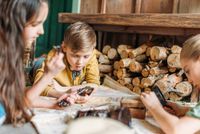3 Benefits of Teaching Children About Local Historic Houses & Events

In many of today’s classrooms, the study of history focuses on national or international events. However, students can benefit from lessons that extend beyond world events to include local history—the events, important leaders, and historic houses in their own communities.
Below are some of the ways learning about local history can enrich a child’s perspective:
- It Is Relatable: Learning about local history can help students relate historical events to their own lives and to the place where they live. While world or national history is somewhat remote in time and space from a child’s personal experience, local history has happened in their own town and may even include family names of people they’ve met.
- It Promotes Community Pride: Local history happened where the child lives. They’ll learn about important contributions of an ancestor or neighbor or discover for whom a street, road, or school is named after. Because they are a part of the community, they are also a part of its history, and that sense of belonging may promote a feeling of pride and a desire to contribute to the community’s success.
 It Is Interactive: Unlike national or world history lessons that are typically conducted in a classroom with textbooks, local history is alive and interactive. Through exploration of historic houses and buildings, interaction with displays of historical events in local history museums, and observation of re-enactments, students can experience a “living history” and learn about the past first-hand.
It Is Interactive: Unlike national or world history lessons that are typically conducted in a classroom with textbooks, local history is alive and interactive. Through exploration of historic houses and buildings, interaction with displays of historical events in local history museums, and observation of re-enactments, students can experience a “living history” and learn about the past first-hand.
Families and educators will discover a wealth of local history lessons for their children and students at the Pink Palace Family of Museums in Memphis, TN. With exhibits featuring the natural and cultural history of the mid-South, to historic houses like The Mallory-Neely and Magevney houses, you’ll find plenty to pique your students’ interest and promote pride for their community. Call (901) 636-2362 to speak to an associate or visit their website to learn more.
About the Business
Have a question? Ask the experts!
Send your question

